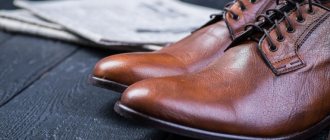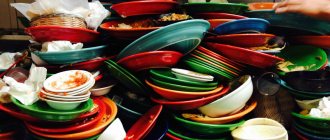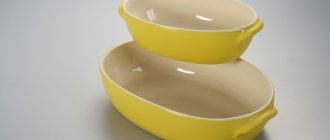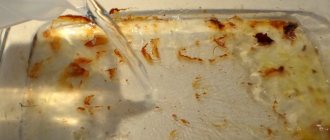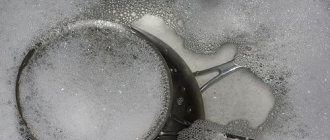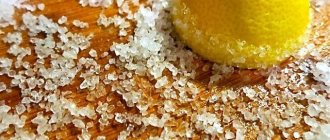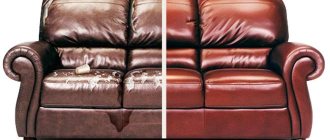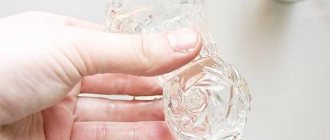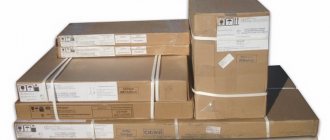How to wash paraffin?
To quickly deal with the problem of removing wax marks on dishes, leather and other objects, we recommend several options for products that you probably have on hand. Depending on the type of surface on which the paraffin came into contact, choose the ones that are more convenient for you.
- fire source;
- large container with water;
- plastic knife, card, CD;
- steel wool;
- soda ash;
- dishwashing detergent;
- rag, rags;
- vegetable oil;
- paper napkins, towels, newspapers;
- turpentine;
- alcohol;
- denatured alcohol;
- ice;
- iron;
- hair dryer;
- vacuum cleaner.
How to wash dishes from paraffin?
Most often, candles are placed in different dishes so as not to stain the furniture with dripping drops. Removing wax from dishes is not difficult if you know what methods to use.
Method 1
This option is suitable for plastic, metal, glass and Teflon-coated cookware.
Since paraffin, once on the surface, quickly hardens, you can simply scrape it off:
- Use a plastic object to pick up the edge of the paraffin stain.
- Remove the main part.
- Scrape carefully.
- Use a hair dryer to heat the surface to be cleaned.
- Remove any excess with a paper towel.
Important! Do not use sharp or iron objects when cleaning to avoid damaging the surface.
Method 2
To remove wax from dishes, use hot water:
- Place a container of water on the fire.
- Place paraffin-soaked dishes in it.
- Add detergent.
- Bring to a boil.
- Drain the water.
- Rinse the dishes under hot water.
- Wipe with a cotton rag.
Important! The effect will be greater if you use soda ash instead of detergent.
Method 3
Wash off paraffin stains with baking soda and steel wool:
- Scrape off the main part of the paraffin with a plastic object - a card, a spatula.
- Apply a little baking soda to a washcloth and wipe away any remaining marks.
- Wash the surface under running hot water.
- Polish with dish soap.
- Rinse.
Important! Every housewife from time to time has to solve various household problems, especially in relation to kitchen utensils. Keep in mind a few more useful tips for caring for different utensils:
- How to clean glassware until it shines?
- How to clean a mug from tea stains?
- How to clean plates from yellow deposits?
- How to clean burnt dishes?
Method 4
- Place a kettle of water on the fire.
- Take a dish contaminated with paraffin or wax and place it under steam.
- Wipe off melted paraffin with paper napkins or towels.
- Repeat the procedure if necessary.
Important! Use this method carefully on glass to prevent it from cracking; dip the item in hot water before exposure to steam.
How to remove wax from dishes using household chemicals
Using a variety of household chemicals will also help remove wax from dishes. The most popular options in this case are:
- Washing powder. In order to get rid of stains in this way, it is necessary to expose wax stains to heat by placing the soiled item under running hot water (temperature at least 50 ° C) after the substance becomes soft. Next, use a sponge and regular washing powder to remove any remaining substance from the surface of the product.
- Liquid for removing dirt from the internal surfaces of ovens and microwave ovens. These products are distinguished by a high alkali content in their composition, so they cope with the task quite easily and quickly. To get the result, you need to apply this product directly to the wax impression and leave everything like that for about 10 minutes. After waiting time, you need to wipe the household item and wash it in the usual way.
- "White Spirit". It will help to cope with old and heavy paraffin stains. Apply this product to a clean rag and wipe the stains with it. The procedure should be continued until the contamination is completely removed. After this, the product should be washed thoroughly using your usual detergent.
How to remove paraffin from fabric coverings?
To remove paraffin stains from simple, lint-free fabrics, we recommend several options.
Option 1
- Place a pad of several layers of napkins, toilet paper or cotton rag over the stain.
- Heat up the iron.
- Press it onto the gasket; under the influence of high temperature, the paraffin melts and is absorbed into the paper.
- Repeat this step until the gasket is dry.
- After this procedure, a greasy stain will remain on the fabric; to remove it, use laundry soap or concentrated detergent.
- Apply to stain.
- Leave it for some time to take effect.
- Wash in washing machine.
Important! Try not to extend the iron past the edges of the pad.
Option 2
This method excludes the use for synthetic fabrics:
- Place a cotton rag soaked in denatured alcohol under the stain on the wrong side.
- Place a layer of blotting paper on the front side of the stain.
- Iron with a hot iron.
- Change the paper until the grease stain no longer appears on the surface.
- Soak a cotton swab in purified gasoline.
- Blot the grease stain onto the fabric.
- Wash it in a way that suits you
Option 3
If the stain is small:
- Take the item stained with paraffin.
- Place it in a plastic bag.
- Place the bag in the freezer.
- When the paraffin becomes brittle, break it into small pieces.
- Remove with a soft brush.
Option 4
- Apply a thick layer of product to the stain.
- Leave for several hours.
- Wash the item in the washing machine using stain remover powder.
Important! When finishing washing, be sure to take into account the cleaning rules for different materials. The recommendations from our article “What and how to wash clothes from different fabrics?” will help you with this.
Warnings
To avoid unpleasant consequences when cleaning wax, there are several points to consider. Namely:
- There is no need to empty the contents of the candlestick into the sink. Otherwise, the pipe may become clogged.
- The window must be open while melting the wax in the oven or using a hair dryer.
- Sudden temperature changes must be avoided to avoid damaging the glass.
- Do not heat candle wax in the microwave. Since chemical fumes can damage the heating element.
- Do not use the dishwasher on items with wax residue because the wax flakes may clog the filter.
- Before using the candle, you need to pour a little water into the bottom of the candle holder so that the wax sticks to the bottom less.
- When removing the pan with the candle holder from the oven and cleaning the wax, it is necessary to use heat-resistant surfaces and heat-resistant gloves.
- When choosing how to wash wax off glass, it is better to give preference to fleece rags or paper towels.
- Use a plastic knife or a special ceramic scraper to avoid scratching the glass surface when scraping out the wax.
How to remove wax from glass is a task that anyone can face. In order to successfully cope with it, it is important to know some subtleties. They will help remove contamination quickly and effortlessly. A properly selected method will allow things to please their owner with their appearance for a long time.
How to remove paraffin from carpet?
The carpet can also be damaged by wax, but drops can be quickly removed using the following methods.
Method 1
The cold will come to your aid. Of course, you can’t put a carpet in the freezer, but use ice as an alternative:
- To avoid getting the carpet wet, place pieces of ice in a plastic bag.
- Apply the bundle to the stain for a while.
- Once the paraffin has hardened, use a heavy object to crush the paraffin into small pieces.
- Brush the carpet with a stiff brush.
- Vacuum.
Method 2
- Clean off paraffin if possible.
- Place several layers of white cotton rag over the stain.
- Cut a hole in a piece of cardboard slightly larger than the spot.
- Place the cardboard on the fabric.
- Apply a hot iron to this structure using pressing movements.
- Make sure that the bottom of the iron does not extend beyond the edges of the cardboard and does not touch the carpet pile.
- Change the fabric until the greasy mark no longer appears.
- Clean with a stiff brush.
Important! Care for carpets in the house must be regular, otherwise the coverings will accumulate dirt, dust, small debris, and also become sources of unpleasant odors. To prevent this from happening and to avoid tiring yourself with time-consuming household chores, check out some simple ways to clean your carpet quickly and effectively.
How to remove depilatory wax from dishes
Waxing is one of the most popular and effective methods of getting rid of unwanted hair. To perform the procedure, wax is used in liquid form, straightened by heating. Therefore, a small amount of the substance often remains on the dishes, which is very difficult to wash off. Not wanting to waste time on long and painstaking washing of dishes, women ask themselves: how and what is the best way to wash wax?
How to remove wax from skin?
If you decide not to use the services of a beauty salon, but to do hair removal yourself, be prepared for the fact that wax marks will remain on your skin after the procedure. What to do in this case?
Method 1
- Soak a cotton swab in vegetable or cosmetic oil.
- Rub the stained area until all traces of wax are completely removed.
Method 2
Alternatively, cosmetic milk or cream will come to your aid:
- Apply the product to the stained area.
- Leave it for a while.
- Use a cotton swab to remove any remaining wax.
- Rinse off with warm water.
Method 3
- Wipe the contaminated area with alcohol.
- After the procedure, lubricate your skin with oil or moisturizer.
How to clean wax from a wax melting bowl
There are several ways to remove wax from a wax melter. Each has its own advantages and disadvantages.
Alcohol wipes
Alcohol wipes are the easiest way to clean a wax melter from wax at home. You can buy them at any pharmacy. Rapid dissolution of the remaining substance occurs under the influence of isopropyl alcohol.
Solutions
To remove wax residues, any solution with an alcohol content exceeding 40% is suitable. In this case, regular vodka is not suitable.
Post-epilation cleansing oil
An oil intended for cleansing the skin after the procedure is also suitable for cleaning the wax melter. Wax is characterized by good dissolution in oil. The product is poured into a wax melter, after which it is easily removed along with any existing dirt using paper napkins or cotton pads. But this method is only suitable for simple stains.
Wipe off any remaining cream
Remove residues with a greasy cream, which should not be used before depilation. The oils included in the cream penetrate between the wax layer and the skin, the contact is broken, and traces are easily removed.
Remove with lotion strip
In beauty salons and stores you can find wax removers in the form of lotions or gels. The only difference between special wipes and bottled preparations is the use: the lotion or spray is applied to the skin and then removed with a wipe along with any remaining wax.
Get rid of it with a hairdryer
A non-trivial method is often used for depilation at home. A cotton napkin or simply a piece of thin cotton cloth is placed on the area and heated with a hairdryer. The flow of warm air is enough to soften the drug and stick to the fabric. Sometimes even an iron is used for the procedure, but, perhaps, this means is too risky.
Vegetable and olive oil
An excellent way to remove wax from a wax melter at home is vegetable or olive oil. Any fatty cream has the same effect. To clean, you need to follow the following steps:
- Apply oil or cream to contaminated areas.
- Leave for about 10 minutes.
- Use cotton pads or napkins to remove any remaining wax.
This method allows you to simply and without much difficulty clean the device from the inside after waxing.
Useful tips
- Handle hot water carefully to avoid scalding.
- Observe safety precautions when using electrical household appliances.
- When using chemicals, ventilate the room.
- Use personal protective equipment - gloves.
- To avoid irritation and other allergic reactions when removing wax from skin:
- Do not wash off the wax with hot water.
- Do not scrub your skin with a hard washcloth.
- Don't use acetone.
Types of surfaces and methods for cleaning them
Paraffin and beeswax quickly eat into various surfaces. Therefore, you need to choose methods for removing such stains depending on the location of the contamination.
Type 1. Cleaning the dishes
You can remove wax from dishes (metal, plastic, glass, Teflon) using many available means.
How to remove wax so that there is no trace left on the dishes:
| Image | Instructions |
Recipe 1. Scraping + heating
| |
Recipe 2. Hot water
| |
Recipe 3. Soda
| |
| Recipe 4. Hot steam |
You can wash wax off glass and other fragile materials using a jet of hot steam:
- Boil the kettle and place the required area of the dishes under the stream of steam.
- Then you need to wipe off the melted paraffin with paper napkins.
- Finally, rinse the container in cold water.
This method is only suitable for heat-resistant cookware.
Type 2. Cleaning candlesticks
Cleaning a candle holder from paraffin is quite a difficult task. You need to choose a method based on the material of the stand itself. Let's consider the possible options:
| Recipe 5. Oil You can clean wax that has stuck in a thick layer inside a metal bowl or pan in this way:
|
You can dissolve wax in hot water
The easiest and fastest way to clean a glass cup from wax or paraffin residue is to dissolve it with hot water and rinse off the residue.
Do not pour hot wax into the sink under any circumstances, you risk clogging the plumbing, the wax will harden and block the water drain!
The melting point for wax is 64 degrees, for paraffin - 50 degrees. When heated together with water, paraffin and wax float to the surface.
Before cleaning the candlestick from wax, put a saucepan with a small amount of water on the fire. We lower the glass candlestick to the bottom so that water does not flow inside. Heat the water until it becomes hot tea. Wait for the wax to melt so you can easily remove it with a paper towel. Throw the remaining wax into the trash bin along with the napkin. Wash the cup with hot water and regular dish soap.
You can just use very hot tap water. Place the jar in the sink, blocking the drain. Now pour hot water directly into the jar. The remaining wax should melt and float to the surface. The water should cool down within fifteen minutes. You can easily remove wax floating on the surface.
Use a knife to remove any residue. The wax should be soft and pliable. If you want to get the effect of pure transparent glass, then moisten a dish sponge in hot water, and lightly wring it out, apply it to the walls of the candlestick. A damp paper towel will also work for this purpose.
Wax and paraffin - what's the difference?
In most cases, when people think of wax, they think of candles. However, this is not entirely true. Candles are made from paraffin and stearin, but the wax itself is used for cosmetic and medicinal purposes.
Wax can be natural or artificial. It is found in the animal and plant world and is a simple lipid. However, the molecules of the substance, unlike other fats, do not contain glycerol. The substance has low chemical activity, is insoluble in water, but dissolves well in gasoline, ether and chloroform.
Among animal waxes the following stand out:
- bee, secreted by special glands of bees, used by them to build honeycombs;
- wool or otherwise called lanolin, has a protective function, protects the skin and hair of animals from excessive pollution and loss of moisture;
- spermaceti, obtained from sperm whale oil of the same name.
Plant waxes cover a small layer of leaves, fruits and stems of plants, and are included in some seeds. Their main function is to protect against moisture loss, exposure to pathogenic microorganisms, and excessive soaking with water.
A large number of plants are capable of producing so-called epicuticular wax, which can reflect ultraviolet and infrared radiation.
Reference! Jojoba oil, widely used in cosmetic products, is also a natural wax.
Fossil waxes include ozokerite.
The most well-known artificial waxes are paraffin and stearin.
- Paraffin is a wax-like mixture made from petroleum. The substance melts at a temperature of 45-65 degrees, which allows it to be used in the manufacture of candles, food, and cosmetic products.
- Stearin, in turn, is a solid substance that is greasy to the touch. Its melting point is 53-65 degrees.
Wax and paraffin are similar substances in their properties. Therefore, just as you clean dishes from wax, you should do the same with paraffin.
Disadvantages of waxing
The procedure itself is simple: the substance is applied in a thin layer to the surface of the skin or a material with a wax preparation is applied to it (for example, strips for depilation in the bikini area), and when it hardens slightly, it is removed with a sharp movement along with the adhered hairs. It is obvious that despite its simplicity, such an action has obvious disadvantages:
- painful sensations are guaranteed even for those who have a low level of sensitivity, unlike, for example, Lova Lova depilatory creams;
- if the removal is not entirely correct, a hair may grow under the skin, which can lead to inflammation;
- Depilation does not remove short hairs. The minimum length at which the procedure is feasible is 5 mm;
- It is prohibited to remove with wax for any diseases that affect the structure of the skin - diabetes, varicose veins, etc.
The video explains how to wash off depilatory wax (how to get rid of it):
Pregnancy and breastfeeding are also contraindications. You can find out what the difference between hair removal and depilation is here.
For the procedure in beauty salons, three compositions are used, slightly different in properties. Depending on the drug, the consequences also vary:
- Soft wax - or warm , contains pine resin and softeners - beeswax and honey. This form is used both in beauty salons and at home, as it greatly simplifies the procedure. Under the influence of the drug, the skin pores expand, which makes removal easier. However, the general consensus is that the pain is greater than with hot waxing. The main disadvantage of this method is the residue of the substance on the skin. The drug is insoluble in water, so it is not so easy to remove.
- Hard wax - or hot . Made from pine resin and wax obtained from petroleum products. It is more often used in beauty salons: it is easier to store and store. Before use, the composition is heated for 20–40 minutes and applied to the skin quite hot. At the same time, the skin pores open up more, and depilation occurs less painfully. The first drawback is the same as in the case of a soft composition - the drug is insoluble in water and is difficult to remove. The second is due to the fact that in a frozen state the substance loses its ability to hold anything. If the preparation cools too much on the skin, the hairs will simply slip out of the wax mass and, accordingly, remain in place. It is this feature of the material that makes us refuse to use it at home.
- Water-soluble wax is a cream containing honey and sugar. Before use, the composition is warmed up to a warm state and applied to the hairs, not to the skin. After hardening, it is removed along with the hairs. The method is attractive because it provides a longer period of smoothness - about 6 weeks. There are no problems with removing sticky traces here: the drug dissolves in water, since a damp cloth is enough to clean yourself up. However, this method also has many disadvantages.
- Higher pain, so the method is recommended for depilation only on the arms and legs.
- The minimum length of hairs is greater - at least 6 mm.
- Not as effective as depilation with “real” wax, as it misses short hairs.
Find out which cream is good for acne.
Reviews of the cosmetic steam inhaler Chamomile 3: .
Here are the reasons for the appearance of subcutaneous acne on the forehead.
How to remove wax from dishes
To get rid of substance residues on dishes, in most cases, you can use mechanical methods, for example, scraping with a knife or spatula, and then rinsing. But how to remove wax from dishes on which the use of physical force is unacceptable?
Degreasing and removal
One of the effective ways to remove depilatory wax from dishes without damaging it is to degrease and then remove the substance. The method involves performing the following steps:
- First you need to fill a large saucepan or any other large container with water.
- Then add detergent and stir.
- Place dirty dishes in water and place on the stove.
- After the water boils, the wax will come off on its own, and the detergent will not allow it to stick back.
This method is the most gentle for how to wash dishes from wax, since its use does not require scratching or rubbing the dishes with a knife. Can be used on various surfaces. In this regard, this method is suitable for crystal products, dishes made of porcelain and crystal.
Steam and boiling water
Another option for removing depilatory wax from dishes is to use steam and boiling water. To do this you should:
- Boil water in any container; a kettle is best for this.
- Place dirty dishes over steam with the parts that need to be cleaned.
- Then use a clean paper towel or soft absorbent cloth to remove any remaining substance from the surface.
The wax should be wiped off when it begins to melt; to completely remove it, you will need to use paper napkins several times.
When using this method for glassware, it must first be immersed in hot water so that it does not crack under the influence of hot steam.
Carefully! Performing this method requires special care, as you can easily get burned.
Other methods with heating
Any source of fire, for example, a fire, stove, burner, etc., is also suitable for removing residual substances from dishes. For cleaning you will need:
- Place the container on the fire with utmost care and heat the wax. It is important to ensure that the wax does not burn, but melts.
- Remove the melted substance using available means, for example, paper napkins, newspapers, dry towels and other unnecessary materials.
This method is suitable for cast iron products, pots, ladles, and frying pans.
Special tools must be used to place the cookware on the fire . Heat-resistant tongs and, in extreme cases, gloves are most suitable for this.
When using any methods using heating, it should be taken into account that the cookware must be resistant to high temperatures, i.e. must be made of heat-resistant materials.
To remove residual substances, you can also use ordinary soda. To do this, first remove the wax using a plastic spatula or the back of a knife, while grabbing it from the edges. Then apply a little baking soda to the sponge and rub the remaining mark. After processing, the dishes should be washed in cold water using detergent.
Important! The soda method is not suitable for metal cookware, especially if it has an enamel or non-stick coating.
You can also clean metal utensils or pots with stuck wax using vegetable oil. To do this you should:
- Place the soiled container on the fire until the substance melts.
- Add a little vegetable oil to the bowl and mix thoroughly.
- Remove from heat.
- Using paper napkins, remove the resulting substance.
- Wash dishes in cold water using detergent.
To remove the substance, you can also use alcohol wipes, sold at any pharmacy. But they should only be used to wipe dishes that have not yet cooled down, since after the substance hardens they will be ineffective.
You can also use special products to remove depilatory compounds. They will easily help you get rid of substance residues on dishes after the waxing procedure. However, these products are quite expensive and cannot be found everywhere.
You can remove the product after waxing using a hairdryer. The substance is heated and removed using paper napkins. However, this process is quite labor-intensive and takes a lot of time to complete.
It is recommended to remove any remaining wax immediately after the procedure. The more time passes, the more difficult it will be to get rid of the remaining substances in the future.
And here is information on how to get rid of unnecessary hair using potassium permanganate.
Cleaning nuances
To get rid of residual dirt on the surface of bowls, plates or other cutlery, mechanical cleaning methods are used. The best option is to clean the surface with a wooden spatula or knife, after which the products are rinsed with water. This method is not applicable to all dishes; scratches may appear on some coatings after exposure to mechanical means. Next, we will familiarize ourselves with the means for cleaning dishes if the use of knives and scrapers is unacceptable.
Degreasing
Not every housewife knows how to wash glassware until it shines. The best method is degreasing and subsequent cleaning of the surface from wax. The work is carried out according to the following algorithm:
- Place a small amount of water in a large saucepan or other metal container;
- add the cleaning agent and mix the ingredients thoroughly;
- place a dirty bowl or other object in the cutlery and put the pan on the fire;
- after the liquid boils, the wax will come off the surfaces, while at the same time the detergent forms a stable protective film and will not allow the paraffin to stick back.
Now we know how to wash glassware until it shines. This method is considered one of the most popular; when using it, you can do without a knife or scraper. Hot water together with detergent cleans any surface well. This applies to products made of glass, crystal or porcelain.

